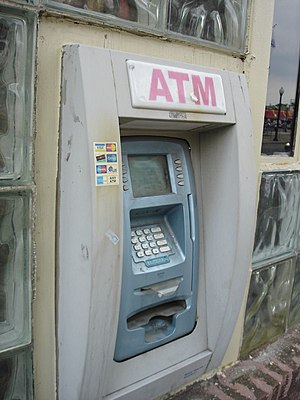
- Image via Wikipedia
Understanding and Managing Cybercrime
by Jordan Robertson
A hacker has discovered a way to force ATMs to disgorge their cash by hijacking the computers inside them.
The attacks demonstrated Wednesday at a security conference were done at stand-alone ATMs. But they could potentially be used against the ATMs operated by mainstream banks, the hacker said.
Criminals use many ways to tamper with ATMs, ranging from sophisticated to foolhardy: installing fake card readers to steal card numbers, and even hauling the machines away with trucks in hopes of cracking them open later.
Computer hacker Barnaby Jack spent two years tinkering in his Silicon Valley apartment with ATMs he bought online. These were stand-alone machines, the type seen in front of convenience stores, rather than the ones in bank branches.
His goal was to find ways to take control of ATMs by exploiting weaknesses in the computers that run the machines.
He showed off his results at the Black Hat conference, an annual gathering devoted to exposing the latest computer-security vulnerabilities.
In one demonstration Tuesday, Jack, director of security research for IOActive Inc. in Seattle, showed how to get ATMs to spit out money:
He found that the physical keys that came with his machines were the same for all ATMs of that type made by that manufacturer. He figured this out by ordering three ATMs from different manufacturers for a few thousand dollars each. Then he compared the keys he got with pictures of other keys, found on the Internet.
He used his key to unlock a compartment in the ATM that had standard USB slots. He then inserted a program he had written into one of them, commanding the ATM to dump its vaults.
This article appeared on page D – 6 of the San Francisco Chronicle





![Reblog this post [with Zemanta]](https://img.zemanta.com/reblog_e.png?x-id=e39877b8-3658-48d6-a82b-d789a6584701)

![Reblog this post [with Zemanta]](https://img.zemanta.com/reblog_e.png?x-id=fdb4c0e1-9dfb-4fb9-b9cc-67ec87f659a8)


